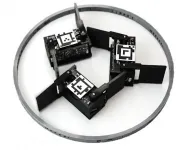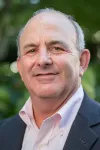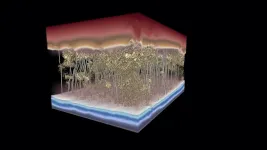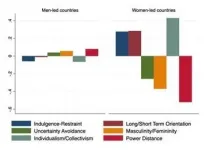(Press-News.org) Predicting when and how collections of particles, robots, or animals become orderly remains a challenge across science and engineering.
In the 19th century, scientists and engineers developed the discipline of statistical mechanics, which predicts how groups of simple particles transition between order and disorder, as when a collection of randomly colliding atoms freezes to form a uniform crystal lattice.
More challenging to predict are the collective behaviors that can be achieved when the particles become more complicated, such that they can move under their own power. This type of system - observed in bird flocks, bacterial colonies and robot swarms - goes by the name "active matter".
As reported in the January 1, 2021 issue of the journal Science, a team of physicists and engineers have proposed a new principle by which active matter systems can spontaneously order, without need for higher level instructions or even programmed interaction among the agents. And they have demonstrated this principle in a variety of systems, including groups of periodically shape-changing robots called "smarticles" - smart, active particles.
The theory, developed by Dr. Pavel Chvykov at the Massachusetts Institute of Technology while a student of Prof. Jeremy England, who is now a researcher in the School of Physics at Georgia Institute of Technology, posits that certain types of active matter with sufficiently messy dynamics will spontaneously find what the researchers refer to as "low rattling" states.
"Rattling is when matter takes energy flowing into it and turns it into random motion," England said. "Rattling can be greater either when the motion is more violent, or more random. Conversely, low rattling is either very slight or highly organized -- or both. So, the idea is that if your matter and energy source allow for the possibility of a low rattling state, the system will randomly rearrange until it finds that state and then gets stuck there. If you supply energy through forces with a particular pattern, this means the selected state will discover a way for the matter to move that finely matches that pattern."
To develop their theory, England and Chvykov took inspiration from a phenomenon - dubbed dubbed - discovered by the Swiss physicist Charles Soret in the late 19th century. In Soret's experiments, he discovered that subjecting an initially uniform salt solution in a tube to a difference in temperature would spontaneously lead to an increase in salt concentration in the colder region -- which corresponds to an increase in order of the solution.
Chvykov and England developed numerous mathematical models to demonstrate the low rattling principle, but it wasn't until they connected with Daniel Goldman, Dunn Family Professor of Physics at the Georgia Institute of Technology, that they were able to test their predictions.
Said Goldman, "A few years back, I saw England give a seminar and thought that some of our smarticle robots might prove valuable to test this theory." Working with Chvykov, who visited Goldman's lab, Ph.D. students William Savoie and Akash Vardhan used three flapping smarticles enclosed in a ring to compare experiments to theory. The students observed that instead of displaying complicated dynamics and exploring the container completely, the robots would spontaneously self-organize into a few dances -- for example, one dance consists of three robots slapping each other's arms in sequence. These dances could persist for hundreds of flaps, but suddenly lose stability and be replaced by a dance of a different pattern.
After first demonstrating that these simple dances were indeed low rattling states, Chvykov worked with engineers at Northwestern University, Prof. Todd Murphey and Ph.D. student Thomas Berrueta, who developed more refined and better controlled smarticles. The improved smarticles allowed the researchers to test the limits of the theory, including how the types and number of dances varied for different arm flapping patterns, as well as how these dances could be controlled. "By controlling sequences of low rattling states, we were able to make the system reach configurations that do useful work," Berrueta said. The Northwestern University researchers say that these findings may have broad practical implications for microrobotic swarms, active matter, and metamaterials.
As England noted: "For robot swarms, it's about getting many adaptive and smart group behaviors that you can design to be realized in a single swarm, even though the individual robots are relatively cheap and computationally simple. For living cells and novel materials, it might be about understanding what the 'swarm' of atoms or proteins can get you, as far as new material or computational properties."
INFORMATION:
The study's Georgia Tech-based team includes Jeremy L. England, a Physics of Living Systems scientist who researches with the School of Physics, Dunn Family Professor Daniel Goldman, professor Kurt Wiesenfeld, and graduate students Akash Vardhan (Quantitative Biosciences) and William Savoie (School of Physics). They join graduate student Pavel Chvykov (Massachusetts Institute of Technology), along with professor Todd D. Murphey and graduate students Thomas A. Berrueta and Alexander Samland of Northwestern University.
This material is based on work supported by the Army Research Office under awards from ARO W911NF-18-1-0101, ARO MURI Award W911NF-19-1-0233, ARO W911NF-13-1-0347, by the National Science Foundation under grants PoLS-0957659, PHY-1205878, PHY-1205878, PHY-1205878, and DMR-1551095, NSF CBET-1637764, by the James S. McDonnell Foundation Scholar Grant 220020476, and the Georgia Institute of Technology Dunn Family Professorship. Any opinions, findings, and conclusions or recommendations expressed in this material are those of the authors and do not necessarily reflect the views of the sponsoring agencies.
High in the clouds, atmospheric aerosols, including anthropogenic air pollutants, increase updraft speeds in storm clouds by making the surrounding air more humid, a new study finds. The results offer a new mechanism explaining the widely observed - but poorly understood - atmospheric phenomenon and provide a physical basis for predicting increasing thunderstorm intensity, particularly in the high-aerosol regions of the tropics. Observations worldwide have highlighted aerosols' impact on weather, including their ability to strengthen convection in deep convective clouds, like those ...
A new analysis suggests that, by 2040, 19% of the world's population - accounting for 21% of the global Gross Domestic Product - will be impacted by subsidence, the sinking of the ground's surface, a phenomenon often caused by human activities such as groundwater removal, and by natural causes as well. The results, reported in a Policy Forum, represent "a key first step toward formulating effective land-subsidence policies that are lacking in most countries worldwide," the authors say. Gerardo Herrera Garcia et al. performed a large-scale ...
When the COVID-19 pandemic reached Africa, the continent was already struggling to deal with another public health crisis - a growing cancer epidemic characterized by more than one million new cancer cases and nearly 700,000 deaths per year. In a Perspective, Beatrice Wiafe Addai and Wilfred Ngwa discuss the significant challenges COVID-19 imposed on cancer prevention and control in Africa and how the efforts to address these challenges highlight key opportunities where greater investment could improve cancer care globally. At the start of the pandemic, many African ...
Overcoming a key obstacle in achieving diamond-based electronic and optoelectronic devices, researchers have presented a new way to fabricate micrometer-sized diamonds that can elastically stretch. Elastic diamonds could pave the way for advanced electronics, including semiconductors and quantum information technologies. In addition to being the hardest materials in nature, diamonds have exceptional electronic and photonic properties, featuring both ultrahigh thermal and electric conductivity. Not only would diamond-based electronics dissipate heat more quickly, reducing the need for ...
CHAPEL HILL, NC--Boosting immune system T cells to effectively attack solid tumors, such as breast cancers, can be done by adding a small molecule to a treatment procedure called chimeric antigen receptor-T (CAR-T) cell therapy, according to a study by researchers at the UNC Lineberger Comprehensive Cancer Center. The boost helps recruit more immune cells into battle at the tumor site. The findings are published in the Journal of Experimental Medicine.
CAR-T immunotherapy, in which T cells are modified in the laboratory to express chimeric antigen receptors, CARs, that in turn target surface proteins ...
Producing clean water at a lower cost could be on the horizon after researchers from The University of Texas at Austin and Penn State solved a complex problem that has baffled scientists for decades, until now.
Desalination membranes remove salt and other chemicals from water, a process critical to the health of society, cleaning billions of gallons of water for agriculture, energy production and drinking. The idea seems simple -- push salty water through and clean water comes out the other side -- but it contains complex intricacies that scientists ...
Diamond is the hardest material in nature. But out of many expectations, it also has great potential as an excellent electronic material. A joint research team led by City University of Hong Kong (CityU) has demonstrated for the first time the large, uniform tensile elastic straining of microfabricated diamond arrays through the nanomechanical approach. Their findings have shown the potential of strained diamonds as prime candidates for advanced functional devices in microelectronics, photonics, and quantum information technologies.
The research was co-led by Dr Lu Yang, Associate Professor in the Department of Mechanical Engineering (MNE) at CityU and ...
AMES, Iowa - Nature has figured out how to make great membranes.
Biological membranes let the right stuff into cells while keeping the wrong stuff out. And, as researchers noted in a paper just published by the journal Science, they are remarkable and ideal for their job.
But they're not necessarily ideal for high-volume, industrial jobs such as pushing saltwater through a membrane to remove salt and make fresh water for drinking, irrigating crops, watering livestock or creating energy.
Can we learn from those high-performing biological membranes? Can we ...
Countries led by women have not fared significantly better in the COVID-19 pandemic than those led by men- it may be just our Western media bias that makes us think they have!
INFORMATION:
Article Title: "Gender in the time of COVID-19: Evaluating national leadership and COVID-19 fatalities"
Funding: The author(s) received no specific funding for this work.
Competing Interests: The authors have declared that no competing interests exist.
Article URL: https://journals.plos.org/plosone/article?id=10.1371/journal.pone.0244531
...
Very low birthweight infants are at a high risk for anemia and often need blood transfusions to survive. Some doctors use a higher level and some use a lower level of red blood cells to order a transfusion. A National Institutes of Health-funded study suggests that providing a higher threshold of red cells within clinically accepted limits (i.e., using a higher level of red blood cells when ordering a transfusion) offers no advantage in survival or reduction in neurological impairment over a lower threshold.
This large, multi-center randomized clinical trial was conducted ...





